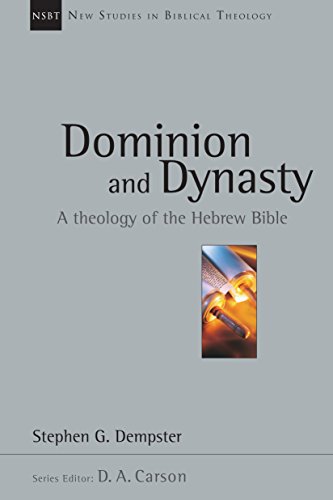A Brief Book Summary from Books At a Glance
By Steve West
About the Author
Stephen Dempster is a professor at Crandall University in Moncton New Brunswick, Canada.
Introduction
This contribution to the New Studies in Biblical Theology series surveys the theology and structure of the Hebrew canon. Dempster carefully looks at how the canonical arrangement highlights certain important biblical-theological themes that develop throughout the unified text. He exposits how individual corpora and books contribute to the overall theological message.
Table of Contents
Chapter 1 A Book or a Ragbag: A Literary Approach to the Old Testament
Chapter 2 The Beginning, Middle, and Ending of the Tanakh: A Preview of the Storyline (Adam to David)
Chapter 3 The Narrative Storyline Begins (Genesis)
Chapter 4 The Narrative Storyline Continues (Exodus to Deuteronomy)
Chapter 5 The Narrative Storyline Continues: The Former Prophets (Joshua to Kings)
Chapter 6 Suspension of the Storyline: Poetic Commentary Begins: The Latter Prophets (Jeremiah to the Twelve)
Chapter 7 Poetic Commentary Continues: The Writings (Ruth to Lamentations)
Chapter 8 Ending of Poetic Commentary and Resumption of Narrative Storyline (Daniel to Chronicles)
Chapter 9 Typology and New Testament Reflections
Summary
Chapter 1: A Book or a Ragbag: A Literary Approach to the Old Testament
Biblical theology is often regarded as the discipline that tries to capture the Bible’s own theology. Interpreters need to avoid the trap of thinking that their interpretation is perfectly objective, but they also need to avoid falling into postmodern skepticism. We learn in community, and we can learn how to read a text appropriately, taking into account its structure and genre. We need to read and reread over and over again, learning the whole from the parts and interpreting the parts on the basis of the whole. Even though the OT was too big for one scroll, the physical separation of its books did not mean conceptual separation or lack of unity. The canonical books were gathered together and considered as a unified Text.
Without denying diversity, the Tanakh was viewed as a unity: there is a structure throughout the whole. Smaller texts have their own local meaning, but are also to be read in wider horizons and locations. We need to read the Bible as literature, seeing it as a literary whole. It is more, not less, than literature—it is God’s Word and needs to be heard and obeyed. It is religious literature and claims to be truth. Scripture is a forest rather than just a bunch of different trees, and it is important to keep the whole forest in view when studying the parts. Some have concluded that there are only micro-narrative or inconsistent parts, but there is in fact a comprehensive and coherent whole unity to the Text. Always zooming-in to small parts of texts hinders proper interpretation.
There is a great deal of evidence that the writers of the canonical books were aware that they fit into the unfolding revelation and shared conceptual unity with previous books. Theologically, this is because of the belief that God was responsible for giving his Word in this form. There are numerous intertextual and inter-canonical connections. Even the canonical arrangement of the OT books is significant. Using a literary approach for the entire Bible, or for the Tanakh, is important. More and more scholars are beginning to recognize how fruitful it can be to apply the literary approach to the OT as a whole. The Hebrew canon has a definite plot and structure.
Chapter 2: The Beginning, Middle, and Ending of the Tanakh: A Preview of the Storyline (Adam to David)
The Tanakh has a structure and identifiable plot. Like a good story, it has a beginning, middle, and end. The beginning establishes context, the middle is filled with developing content, and the ending brings closure. Coherent stories are not haphazardly arranged. One unified plot does not mean that there cannot be numerous sub-plots. In the Tanakh, Genesis is the beginning and Chronicles is the end: the plot is driven in different ways through the remaining books in the middle. Genesis and Chronicles have many differences but also many similarities.
[To continue reading this summary, please see below....]The remainder of this article is premium content. Become a member to continue reading.
Already have an account? Sign In
